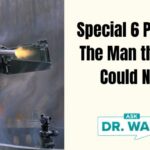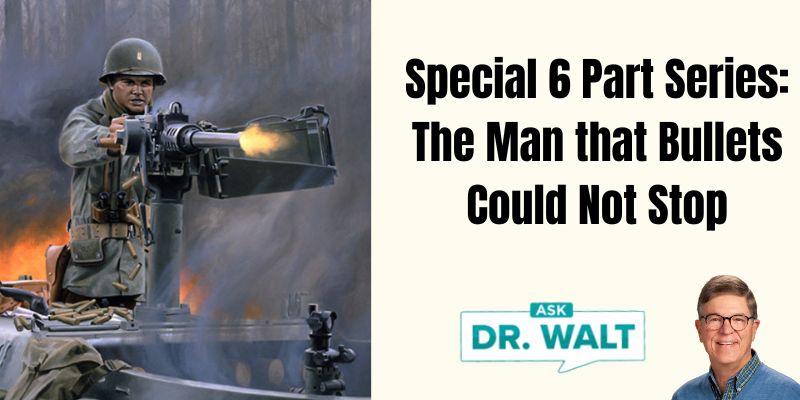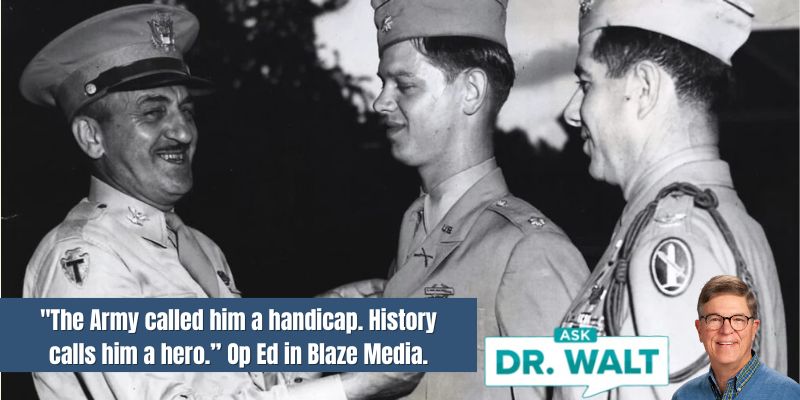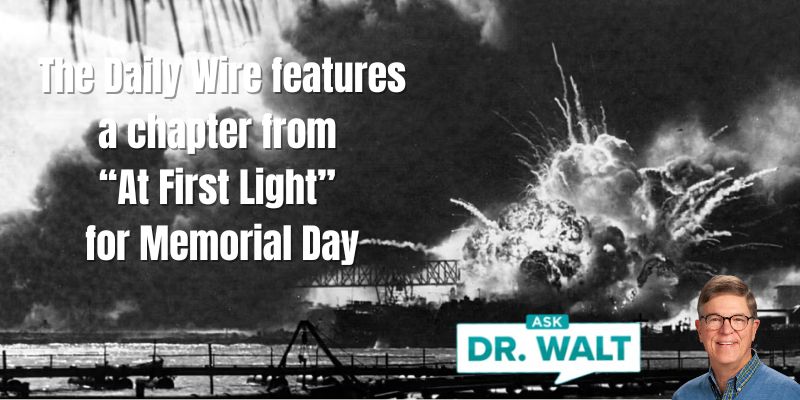
April 7, 1945 — The amazing capture of the Bad Kissingen resort and for a fleeting moment the war was forgotten
April 7, 2025
April 8, 1945 (Part 2) — Phil severely wounded one month before the end of the war
April 8, 2025As Phil and his men slept, Colonel McGarr received orders just after midnight that jump-off was scheduled for 0730 hours the next morning, 8 April 1945. An Intelligence officer, however, warned McGarr that his troops better be prepared to enter the long-predicted buzzsaw as they continued their easterly advance. American forces could expect to meet considerable artillery and anti-tank fire and even more fanatical infantry. Phil was about to enter what would be for him, the worst day of the war.[1]

Phil and his command officers were awakened at 0300 to receive their orders and prepare for a difficult day. During the early morning briefing, the men were told that the Germans could be expected to try, once again, to slow the 3rd Division’s relentless attack, most likely to give the Nazi “bigwigs” a chance to withdraw to the Redoubt area in the Austrian Alps.
What lay ahead for Phil was a day he would never forget.
On the morning of April 8, 1945, Phil and L Company jumped off Bad Kissingen at 0730 with K Company on their right flank. Passing through pastureland bordered by forests, they reached several successive objectives with minimal resistance, overcoming a small firefight at 0950 hours and another at 1005 hours, followed by defeating Germans at three log roadblocks and bypassing another two.
Several of the skirmishes involved hand-to-hand fighting to the death—in this case, resulting in all German deaths. Phil had to take out a German officer at point-blank range when he tried to pull out his Luger in the process of surrendering. The pistol never left the German’s holster before he crashed to the ground, killed instantly by Phil’s quick-draw response.
By 1330 hours, both lead companies began encountering significant machine gun and small arms fire from forested areas bordering their zone of advance. Phil hated hearing the guttural blasts from the German Schmeisser machine guns[2] that GIs called “burp guns.” After fifteen months of nonstop fighting, he detested the fact that Schmeissers fired at twice the rate of the best American-made counterparts, giving the Krauts a battlefield advantage.
Phil called in heavy artillery time and time again, which stalled progress—a development that neither his officers nor NCOs liked. At 1800 hours, they found themselves moving slowly through a wooded section outside the tiny village of Rottershausen.
As the light began to fade, Phil’s company made a flanking move through the dense thicket of trees. They slowed their advance and moved carefully.
Phil found the silence of the woods unnerving. He and his men could feel apprehension in every fiber of their beings. None of them wanted to be the last to die in this war.
The tension was sky-high among his men—higher than any time in the last three days. These were desperate times for the enemy. Intelligence told them that trigger-happy Krauts were infesting the countryside, especially in forested areas, setting up traps and ambushes. Phil was greatly concerned about the dangerous situation developing. His men crept low, darting from tree to tree, most with fingers on their M1 triggers, others hand signaling man to man.
Death could be lurking anywhere in the forest surrounding them. Snipers could be nestled in towering firs or behind their massive bases. Machine gun nests might be hidden behind a camouflage of evergreen boughs prepared to annihilate Phil’s frontline troops in a hailstorm of gunfire. On top of that, one well-hidden artillery piece could fire its rounds into the tree canopy, raining splintered wood and white-hot shrapnel that would cut through flesh like hot knives through butter. Death lurked in every direction.
Three of Phil’s fast-moving platoons advanced to the south and east as he, Fitterman, and his radioman followed. Phil had his compass in one hand and a field map in the other, continually scanning it with trained eyes and an intuition gained from over a year’s experience fighting Germans. He almost always knew what the Krauts were thinking and doing.
Rule of War #15 passed through his mind: Direction: The compass is the infantry officer’s most reliable guide.[3] More attacks failed from the loss of direction than from any other cause.
Suddenly, Phil saw something he had missed—a small clearing ahead, surrounded by a forest edge that was slightly elevated over a small meadow. He had Fitterman radio the point men to skirt the field and remain in the forest.
The woods ahead suddenly crackled with small arms fire and the deep rasping sounds from the German burp guns.
Damn, he thought. Too late!
Suddenly, his radioman’s backpack SCR-300 sizzled with distress. “Love 6, this is point squad alpha.” It was one of his point squad leaders. His strained voice said, “We’ve been ambushed in a glade.” The sergeant added, “There are nine of us and probably 150 Krauts around us. The rest of the platoon behind us is pinned down. We have four wounded. We’re low on ammo. We’re in a clearing. Help needed now, sir!”
“Shit,” Phil whispered to himself, remembering it was one of his least-experienced squads. He could hear German-type potato masher grenades exploding, answered by American grenades and machine gun fire, adding to the pandemonium. Projecting a calmness he didn’t feel, Phil ordered the 1st Platoon on the left flank and the 3rd Platoon on the right to begin an immediate pincer move to save the trapped squad. He also called for a tank. “I need a medium can now!” he bellowed into the radio handset.
He always wondered why he had to call tanks “cans” over the radio. Any German monitor would know what he was referring to. As the battle sounds intensified, he spread his field map on the ground and studied it with Lieutenant Fitterman and their FO, who had just come to the front.
“Our trapped squad must be here,” Phil said, pointing to the northwest edge of the only nearby clearing. Turning to his FO, he said, “I need fire massed on the other side of the clearing.”
He ran his finger along what appeared to be a forest lane on the map. “Abe, you take over the CP staff. When the first tank gets here, I’ll take it to the clearing to get to my guys.”
“I’ll go,” Abe offered. “We need you back here.”
Phil remembered Rule of War #14—Supervision: Leaders must supervise the execution of their orders. The more untrained the troops, the more detailed the supervision must be.
“This one’s on me, Abe.”
Phil radioed the trapped patrol. “Fire coming in. Ammo is on its way. First and 3rd platoons are pinching toward you now.”
Surprised to hear the rumble of three Sherman tanks behind him instead of the one he’d called for, he radioed his frontline men. “We’ve got three cans here. We’re coming up now!”
The reply was filled with panic. “We’re pinned down with marching fire, Love 1! We need help fast!”
As the lead Sherman pulled up, Phil yelled, “Abe, I’m hopping a ride on the lead can! Get artillery firing now!”
Before Abe could object, Phil jumped up on the back of the tank with his radioman in tow. Climbing in behind the turret, he had his radioman hand him an intercom handset that was kept in an empty ammunition container on the back of the tank and stretch the long cord up to him. That would allow him to communicate with the tank commander inside as he signaled to his radioman to hunker down behind him. As the tank lurched forward, Phil prepared the turret-mounted .50-caliber machine gun, unlocking the safety and cocking it. There was not a lot of ammo, but he hoped it would be enough.
His head snapped up at whistling sounds whizzing overhead, just seconds before American artillery projectiles exploded on enemy positions. That’ll sure as hell help me save my guys, Phil thought. Maybe help save me too.
The German MG-42 medium machine gun[5]—nicknamed “Hitler’s buzzsaw” by American GIs—continued erupting at 1,000 to 1,200 rounds per minute to his front. His own men’s machine guns gave studied answers at less than half the rate—the American guns sounding like Model Ts compared to the murderous reverberation of the enemy’s automatic firearm.
Approaching the clearing, Phil crouched behind the turret as green tracer bullets from enemy machine guns peppered the air from the front, while friendly red tracers came from behind on either side of the tank.
“Our guys are fifty yards ahead! Friendly platoons are coming up from behind on our left and right!” Phil called to the tank commander. Into the radio, he yelled, “Second Platoon, send up your remaining squads, pronto! Each one behind a can as we can move up!”
His men sprinted from the forest to the shelter of the tanks, fanning out across the western edge of the clearing, one on his left flank and the other to his right, bullets churning up dirt around them.
“Shermans, move into the clearing!” Phil commanded into the tank handset. He quickly identified three machine gun nests on the other side of the clearing. The tanks lurched forward as fire poured in, the bullets from multiple snipers missing him by only inches. Phil ordered the gunners inside the tanks to use their 76-mm cannons and .30-caliber machine guns to lay down suppressing fire, while he manned the hundred-pound, turret-mounted .50-caliber machine gun, firing and taking fire all the way. He sprayed bursts across the forest line, silencing several snipers and destroying at least three machine gun nests, momentarily quelling the enemy attack.
“I see our guys!” Phil shouted into the SCR-300 handset. “Between the center and left cans! Twenty yards ahead. Let’s get ’em outta here!”[6]
TO BE CONTINUED.
~~~~~
The entire series:
- April 8, 1945 (Part 1) — Phil severely wounded one month before the end of the war
- April 8, 1945 (Part 2) — Phil severely wounded one month before the end of the war
- April 8, 1945 (Part 3) — Phil severely wounded one month before the end of the war
- April 9, 1945 (Part 4) — Phil severely wounded one month before the end of the war
- April 9, 1945 (Part 5) — Phil severely wounded one month before the end of the war
- April 10, 1945 (Part 6) — Phil Larimore the man that bullets could not stop
~~~~~

~~~~~
[1] Larimore, At First Light, 253.
[2] The Schmeisser, or MP 40 (Maschinenpistole 40), was a submachine gun heavily used by German Infantrymen.
[3] In World War II, the Army used inexpensive lesantic compasses because the “marching compasses” of World War I were too large, too elaborate, and too costly.
[4] Phil memorized the “Rules of War” at military boarding school when they were published in 1939.
[5] The MG 42, short for Maschinengewehr 42 or “machine gun 42,” was highly reliable and easy to operate. It was most notable for its high cyclic rate, averaging about 1,200 rounds per minute compared to around 450 to 600 rounds for American machine guns like the M1919 Browning or Bren.
[6] Larimore, Ibid, 253-257.
Learn more about my book about my father’s heroics and exploits at Amazon’s First Light page here. You can also read more of my WWII blogs here as well!
© Copyright WLL, INC. 2025.




